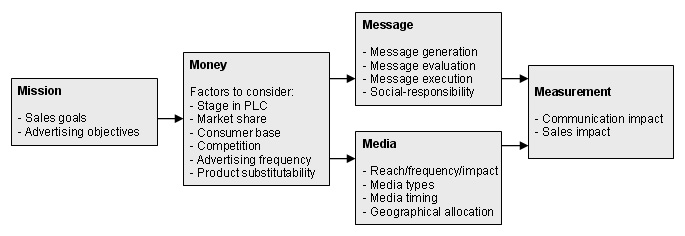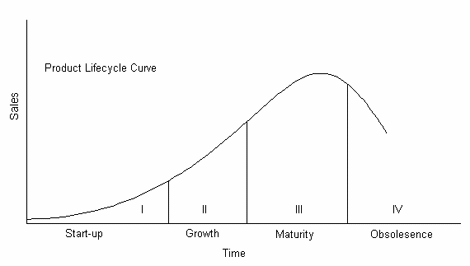Difference between revisions of "Future of Advertising"
m |
|||
| Line 112: | Line 112: | ||
[[How can global culture trends impact advertising?]] <br> | [[How can global culture trends impact advertising?]] <br> | ||
[[What affects the advertising budget? ]] <br> | [[What affects the advertising budget? ]] <br> | ||
[[How much | [[How much time does a person spend on Internet and watching TV? how will it influence advertising? ]] <br> | ||
[[What are the legal issues?]] <br> | [[What are the legal issues?]] <br> | ||
Revision as of 02:22, 24 March 2006
Group Members
Sven Blom
Chen Li
Klaas-Jan Molendijk
Willem de Ruiter
Chaitu Satbhai
Introduction
What is a advertising? According to Wikipedia:
Generally speaking, advertising is the promotion of goods, services, companies and ideas, usually by an identified sponsor.
Research questions
For readability sake – and since these research question are only for internal use - we will not give in text references. All our references can be found on the bottom of this page.
What is advertising?
Generally speaking, advertising is any paid form of nonpersonal promotion of goods, services, companies and ideas, usually by an identified sponsor. Marketers see advertising as part of an overall promotional strategy (i.e. one of the elements of the marketing mix). Other components of the promotional mix include public relations & publicity, personal selling, direct marketing, events and sales promotion.
What are the objectives of advertising?
Advertising objectives can be classified according to whether their aim is to inform, persuade, remind or reinforce.
- Informative advertising. Aims to create brand awareness and knowledge of new products or new features of existing products.
- Persuasive advertising. Aims to create liking, preference, conviction and purchase of a good or service.
- Reminder advertising. Aims to stimulate repeat purchase of a good or service.
- Reinforcement advertising. Aims to convince current purchasers that they made the right choice.
Why is advertising necessary?
<<to be filled in>>
How does advertising fit in marketing?
<<to be filled in>>
What is the general advertising process and which parties are involved?
Organizations handle advertising in different ways. In small companies, advertising is handled by someone in the sales or marketing department, who works with an advertising agency. A large company will often set up its own department, whose manager reports to the “big boss” of marketing. The department’s job is to propose a budget, develop strategy, approve ads and so on.
Most companies use an outside agency to help create advertising campaigns and to select and purchase media. Today, advertising agencies are redefining themselves as “communication companies” that assist clients to improve their overall communications effectiveness. They do this by offering strategic and practical advice on many forms of communication.
The general process can be described with 5 major decisions, the 5 Ms.
NB: Although this is not a complete picture it gives a very good picture of how it works in general.
How can the Product Life Cycle be related to advertising? What will be the life-span accordingly? (what do I have to do with this last question?)
The figure below shows the Product Life Cycle. Each stage of a product’s life requires a different approach of advertising.
- Start-up stage. Build product awareness among early adopters and dealers.
- Growth stage. Build awareness and interest in the mass market.
- Maturity stage. Stress brand differences and benefits.
- Obsolesence stage. Reduce to level needed to retain hard-core loyals.
PART CHEN LI
PART WILLEM
What is the impact of Internet on advertising?
With the dawn of the Internet have come many new advertising opportunities. Popup, Flash, banner, and email advertisements (the last often being a form of spam) are nowadays widely known.
The Internet has emerged as a medium for marketing and advertising since 1994. The Internet is different from conventional advertising media in several respects. First, it can serve as not only a communications channel but also a transaction and distribution channel. Consumers can get information and make purchases and payments all through the Internet. No other medium can accomplish these marketing functions instantly, without resorting to other means. Second, the Internet is by nature interactive. Users can initiate a shopping process by visiting a Web site and then clicking on hyper-linked text for more information. It is a two-way communication, with the Internet serving as a provider of customized content that meets an individual's needs. Third, it has the capacity for multimedia content. It can carry not only text and graphics but also audio and video content. The multimedia nature of the Internet is suitable for high-impact advertising. The Internet has become an integral part of the media mix for many advertisers, and new forms of advertising have filled the World Wide Web landscape, including animated banner ads, sponsor logos, interstitials, “advertorials,” “advertainment,” and 3-D visualization.
What are the media costs?
Advertising rates are more stable for print media than broadcast media largely because print media can adjust the number of advertising pages on an issue-to-issue basis while broadcast media have a fixed amount of daily programming hours. Thus, demand by advertisers has a stronger impact on the rates for broadcast time. Newspaper space is usually sold according to rate cards; buyers of large volumes get discounted rates. Magazine space is sold similarly. Advertising rates for radio and television are normally determined through negotiation and often vary by the time of day. A 30-second spot on network television costs the most in prime time (8:00 p.m. to 11:00 p.m.) and the least during daytime (10:00 a.m. to 4:00 p.m.). According to Optimum Media, in the third quarter of 1999, a 30-second commercial on U.S. network television cost $190,000 in prime time but $21,960 in daytime. Advertisers use CPM (cost per thousand impressions) and CPP (cost per rating point) to compare media costs. CPM is used for both print and electronic media while CPP is more popular for electronic media. CPM is calculated by multiplying the unit cost of a media vehicle by 1,000 and dividing the result by the audience size of the vehicle. The unit cost of a media vehicle is the cost for a single ad placement in that vehicle. Fro example, if a 30-second commercial in a TV program costs $5,000 and the program has an audience of 250,000, then CMP for the commercial will be $20. CPP is calculated by dividing the unit cost of the media vehicle by the rating of the vehicle. If a 30-second commercial in a TV program costs $5,000 and the program has a rating of 10 in the market, CPP for the commercial will be $500. CPP can also be used to compare newspaper or magazine costs if the audience is described as a percentage.
Which industries advertise most? And which less?
Research did not show that there are certain industries that advertise more than others. It looks like that certain industries do prefer certain media. Movies are mostly advertised during other movies and internet businesses focus more on internet advertisement than other industries. Industries that do not deliver raw material or unfinished costumer goods and B2B do not advertise to the consumer.
<<<Comment from Willem: Sven, I think this is not right, look @ http://www.tns-mi.com/news/02282006.htm>>>
What are the differences between B2C and B2B advertisement?
Although the target of the advertisement is not the same as B2C, there is no difference in the way the advertisement is set up. The way the advertisement is brought to the other business is the same. Focus on B2B advertisement besides product is also service and long term relations.
'Is advertisement mostly done by the company themselves or is it outsourced? ’
At this moment most of the MNC’s have their own advertising departure or they have an entire advertisement company fully available. Nike is a nice example how their advertisement company grew together with Nike and how both existence now rely on each other. Like the outsourcing trend of IT, also advertisement follows the trend to be outsources. While the first major outsourced location was India, now the trend moves slowly to China, Philippines, Malaysia, Singapore, South Africa and Australia. Studies show that this will increase in the future when the western knowledge of these countries improves.
How differs advertising of goods from advertising of services?
<<<to be done later>>>
What are general qualities of advertisements? (e.g. pervasiveness, amplified expressiveness and impersonality)
<<<to be done later>>>
Is the role of advertisement changed in the last decades? And how?
Over the years, the public perception of advertising has become very negative. It is seen as a medium that inherently promotes a lie, based on the purpose of the advertisement - to encourage the target audience to submit to a cause or a belief, and act on it to the advertising party's benefit and consequently the target's disadvantage. They are either perceived as directly lying (stating opinions or untruths directly as facts), lying by omission (usually of terms unfavorable to the customer), portraying a product or service in a light that does not reflect reality or even making up realities where their product has a new role.
Chen Li:
What are important non-technological trends which affect advertising?
What are the social trends which will influence on advertising?
What are the economic trends and how can it impact advertising?
How can global culture trends impact advertising?
What affects the advertising budget?
How much time does a person spend on Internet and watching TV? how will it influence advertising?
What are the legal issues?
Driving Forces
(to do at monday after class)
- Increasing information availebility for consumers (internet comparing)
- Increasing knowlodge of consumer (internet reviews, independend users reflection)
- Increasing populairity of media on demand
- Growing diversity of media (changing consumer's mediabehaviour)
- More personalized adds (individualization)
- Consumer's ability to skip adds
- Growing consumer resistance to adds
Note: just some ideas, we will work on it on monday!
References
(yet incomplete)
- http://www.inc.com/magazine/20050801/future-of-advertising.html
- http://adverlab.blogspot.com/
- http://www.pcmag.com/article2/0,1895,1866501,00.asp
- http://www.economist.com/business/displaystory.cfm?story_id=2787854 (good article)
- http://advertising.about.com/od/planning/a/interactivetv.htm
- http://www.businessweek.com/magazine/content/01_13/b3725020.htm
- http://www.pcworld.com/news/article/0,aid,120065,00.asp
- http://businessweek.com/magazine/toc/06_13/B39770613futureoftech.htm
- http://www.deccanherald.com/deccanherald/jan232006/business1941292006122.asp

